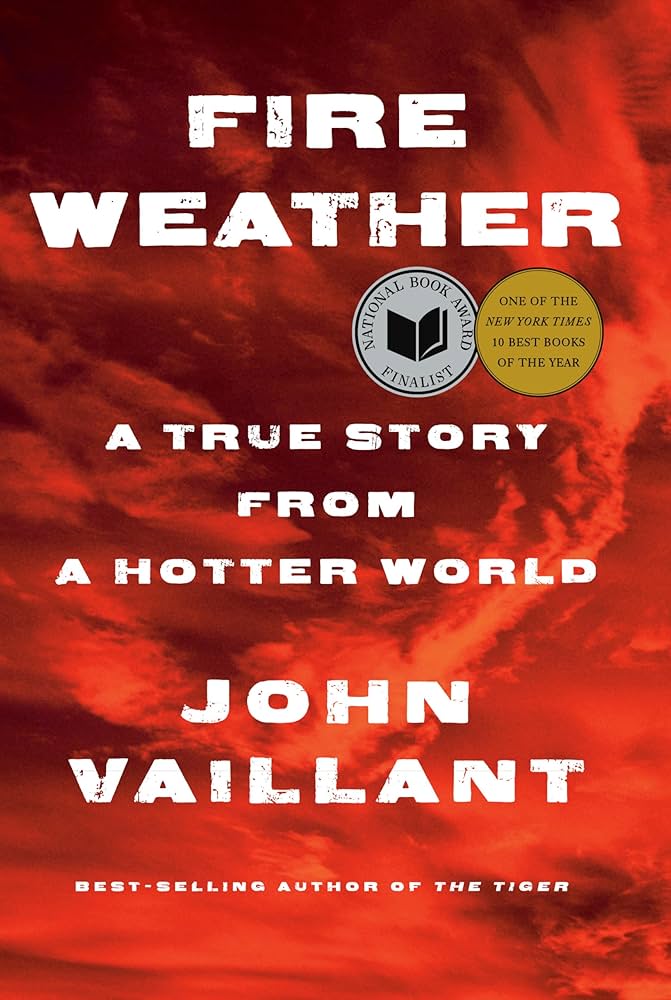
Fire Weather (2023)
On the Front Lines of a Burning World
John Vaillant
rating fantastic
type nonfiction/journalism audiobook
concepts climate petro
2025/08/01 What I learned: all about the bitumin mining industry in Alberta and Fort McMurray; how fur trading played a vital role in the establishment of Canada; the insane power of modern wildfires; the danger and ubiquity of the WUI (the wildlife-urban interface). This is one of those books I felt like I needed to narrate in real-time to someone else in order to fully express my surprise and interest!
- Alberta, Canada → petroleum country, sorta analogous to Texas
- In northern regions, covered by boreal forests (which encircle northern hemisphere, small-ish trees that burn and regrow often)
- Fort McMurray → main city? central to petroleum industry, pretty isolated in a mostly uninhabited region, lots of money
- What actually lies under Alberta isn't oil or even bitumen (basically asphalt/tar) but oil sand, which requires a very unique and resource intensive process to process and extract any petroleum from, only more difficult due to extreme weather conditions in northern Alberta
- Only profitable when price of conventional oil is >$50/barrel, natural resources to produce it (water, land, etc.) free, heavily subsidized industry, no exploration costs (vs Saudi Arabia, which can break even at $5/barrel)
- Due to investment from SynCrude and all the international oil giants, Fort McMurray = center of largest, most expensive, most energy intensive hydrocarbon recovery project on Earth… to date, ~half a trillion $ invested
- History
- Bitumen can be found worldwide; initial uses date back to Mesopotamia, primarily as mortar, waterproofing, etc.
- In Alberta, known to be found and even flow into the Athabasca River
- Hudson's Bay Company → first industrial scale resource extraction in the region, via "wildfire economics": furs as fuel, European market as fire, credit as oxygen
- Offshore capital + indebted labor (of native people in the region as trappers, who also transported furs to trading posts over dangerous terrain) → foundation of modern-day Canada (and Alberta) and set the tone for how extractive industries operate there; "merchant in the guise of a state;" colonial model commodifying natural resources and binding local people to the trading post system with company-store-style debt replicated across the country
- Scale of bitumen mining operations of Fort McMurray = SF Bay, Cape Cod
- Fire has only been present on earth for the past 1/2 billion years; unique to Earth?
- "It's never been a better time in human history to be fire."
- Fire technically = combustion, reaction of hydrocarbons with oxygen → molecular breakdown and assembly into water and carbon dioxide, which generates light, heat, and sound (blue flame); continues in feedback loop while fuel and air supply last
- Red and orange "flames" are actually soot burning
- Creation of ozone layer was critical to maintaining atmospheric oxygen levels at a good concentration for fire to be usable for us
- Chisholm Fire, a few years prior to Fort McMurray, burned 3x faster than the Camp Fire in Paradise, CA— already insanely fast; had to measure energy output in units of "megatons of hydrogen bombs" (during peak 7 hour burn, energy released equivalent of 17 x 1 megaton hydrogen bombs = 4 Hiroshima bombs per minute)
- Hotter and drier air, dryer soil makes latent energy of forests that much easier to release
- The Lucretian Paradox (?): we can't imagine what we haven't personally experienced; the worst thing that can happen has already happened
- "Reality does not require human belief to be real."
- "The greatest shortcoming of the human race is our inability to understand the exponential function." — Albert Allen Bartlett, physicist
- WUI ("woo-ee") = wildland-urban interface → zone where structural firefighting and forest firefighting collide, very different approaches and strategies… fault line between the forest and built environment, and sweet spot in N Am real estate development
- Most dangerous in neighborhoods built with modern, highly flammable materials and located near ecosystems that regulate themselves with wildfires — Australia, Western US
- Learned from fires in the 18–19th centuries best practices for avoiding disaster: don't build houses in a forest, use tin or steel roofs (good defense against falling embers)… all fell away in recent years; "like watching the spread of polio" after people stop vaccinating
- Modern day houses are essentially "petroleum vapor chambers" when faced with boreal fires.. equivalent to black spruce grove
- As houses detonated, tons of different sounds: wood burning, glass shattering, insulation… repeatedly, car alarm, five tires and gas tank exploding, and randomly, a gas grill with 20 lb propane tank
- The transformative power of fire: "Under certain circumstances, fire can alter the nature of things so completely that they are transformed from objects in space to moments in time."
- Entire houses disappeared in 5 minutes— insane when you consider the amount of material, designed to withstand fire, wind, rain, and blizzards —
- All that fires care about: fuel, weather, and topography
- After the first day(s?), best strategy was to use bulldozers, other heavy machinery to knock down houses as a fire break— destroyed 100s of homes, buried cars and trucks in basements to contain fuel → temporarily contained one front of the fire
- At this point, area 10x the size of Manhattan had burned
- Ultimately, incredible that no lives were lost in evacuation— people stayed calm (enough), first responders adapted..
- "I gave them fire, but I have no device to see myself from this disaster." — Escolus (sp?), Prometheus Bound
- "Dissonance, if you are interested, leads to discovery." — William Carlos Williams (?)
- Fort McMurray fire took 15 months to fully die out